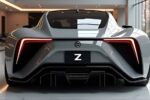Join on WhatsApp
Get the latest updates directly on WhatsApp – motivation, news & more!
The 2026 Ford Everest represents a bold entry into Ford’s SUV lineup a three‑row, body‑on‑frame built sport utility vehicle which brings a blend of rugged capability and modern styling. Unlike many crossover SUVs that share unibody construction, the Everest uses a ladder‑frame design, which makes it well suited to serious utility: towing, off‑road adventures, and heavy‑duty family duties. Analysts note that the Everest builds on the same platform as the latest Ford Ranger and draws styling and engineering cues from Ford’s global body‑on‑frame architecture. The idea is to give buyers who want serious SUV toughness without sacrificing interior comfort, modern tech and family‑friendly practicality a compelling option.
The design upgrades for the 2026 model year bring a more commanding front end, sharper LED lighting elements, wider stance and larger wheel arches. 2025 – 2026 Ford+1 Inside the cabin, there’s an emphasis on premium materials, advanced technology interfaces (such as large center screens, digital instrument clusters) and three‑row seating for up to seven. According to Ford’s media release for other markets: “Bold outside, a sanctuary on the inside” is their phrasing and while U.S.-spec details are still emerging, the indication is that the Everest is intended to offer both ruggedness and refinement.
When will the 2026 Ford Everest be available in the U.S
At present, Ford has not officially confirmed a U.S. launch for the 2026 Everest. Industry sources speculate that the brand is evaluating its entry into the North American market. 2025 – 2026 Ford+1 Should the decision be made, the timeline for availability is projected for late 2025 with customer deliveries beginning early in 2026. 2025 – 2026 Ford+1 As for pricing, early estimates suggest a starting U.S. price in the ballpark of $50,000, with larger or better‑equipped trims potentially reaching $70,000 or more, depending on engine, drivetrain, and options. 2025 – 2026 Ford+1 It’s worth noting that some global versions of the Everest are already available outside North America, but those carry diesel‑engine variants and different specs which may complicate a direct U.S. rollout and pricing comparison.
How has the design and styling been enhanced for 2026?
The new Everest introduces a refreshed exterior that emphasizes both strength and refinement. Up front, expect a wider, more imposing grille, strong horizontal elements, and the signature “C‑clamp” LED daytime running lights that Ford has applied in its global design language. Ford From the Road The wheel arches are more pronounced, the track is slightly wider, and the vehicle’s stance is elevated — all of which communicate off‑road readiness and road presence. Interior upgrades are significant: larger infotainment screens (potentially up to 12″ or more), a full digital instrument cluster, improved connectivity and voice‑activated functions. 2025 – 2026 Ford Materials have also been upgraded — soft‑touch surfaces, premium finishes, ambient lighting and the third row is intended to be more usable than previous generations. The overall feel is less utilitarian and more SUV‑luxury crossover, while retaining solid SUV fundamentals beneath.
How is performance, powertrain
Although Ford has not released full U.S.-market specs for the 2026 Everest yet, analysts indicate that the American version is likely to omit the diesel powertrains offered overseas and instead centre on gasoline or hybrid engines compatible with U.S. emissions standards. 2025 – 2026 Ford+1 Expected engine options include the 2.3L EcoBoost four‑cylinder shared with the Ranger and Bronco, and perhaps a 2.7L or 3.0L EcoBoost V6 for higher trims. 2025 – 2026 Ford A plug‑in hybrid version is also speculated, combining an electric motor and turbo gasoline engine to deliver strong combined output, good all‑electric range and towing credentials. One article claims a PHEV version with around 370 hp, 465 lb‑ft of torque, an all‑electric range of 38 miles and combined rating of 78 MPGe though this is unconfirmed for the U.S. market. Capability is a core part of the Everest’s appeal: body‑on‑frame construction, full‑time 4 × 4, terrain management modes, skid plates, locking rear differential, high towing capacity (in some markets up to ~6,000 lbs or more) are expected.
How does the Everest stack up for U.S. buyers?
For American drivers seeking a three‑row SUV with real rugged capability, the 2026 Everest could be an appealing option. Families benefit from the third‑row seating allowing up to seven passengers and generous cargo space when the seats are folded. The second row is likely to feature sliding and reclining functionality, enhancing comfort on longer drives. The luxury‑SUV feel inside means everyday commuting won’t feel strictly “truck‑like”. On the off‑road or towing side, the tough build, high ground clearance, advanced 4 × 4 capabilities and strong towing capacity give it an edge over conventional crossover SUVs. Particularly for buyers who tow boats, campers, or head off‑road weekend adventures, Everest could fill a niche. The challenge for American buyers will be: availability, pricing, and whether Ford positions it aggressively enough to compete with established rivals such as the Toyota 4Runner, Jeep Grand Cherokee, and larger three‑row SUVs. Borderline overlap with the existing Ford Explorer lineup is another consideration.
How should potential U.S. buyers evaluate waiting or buying now?
If you’re considering the 2026 Everest for the U.S., here are some take‑aways:
- If Ford officially brings the model to America, the combination of rugged build plus modern tech and three rows could make it a standout.
- However, because the U.S. launch is not confirmed yet, waiting may be prudent – especially if you’re committed to getting this exact model.
- Consider how soon you need a vehicle: If you need something now, the risk of supply delays or higher pricing is real.
- Check how the U.S. trims and powertrains compare to overseas versions — U.S. emissions, fuel economy, warranty and local dealer support will all matter.
- Keep an eye on pricing, especially since estimates point to ~$50 K+ for entry versions. That places it near or above many rivals — so value, options, and capability must justify the cost.
- Finally, see whether the Everest will be marketed in your region (some models are region‑limited) and what local dealer network, parts support and service infrastructure will look like.
In short, if you’re drawn to a serious three‑row SUV with off‑road chops and modern features, the 2026 Ford Everest could check a lot of boxes provided Ford chooses to bring it to the U.S. and does so with competitive pricing and good support. If you’d like, I can check which U.S. states might get the earliest allocations, and compare it to direct competitors in the U.S. market. Would you like me to do that?
FAQ: About the 2026 Ford Everest (U.S. Version)
What is the 2026 Ford Everest?
The 2026 Ford Everest is a rugged, three-row SUV built on a body-on-frame platform, similar to the Ford Ranger pickup. It combines off-road capability, modern design, advanced safety features, and family-friendly practicality. Though it has been available in international markets for years, Ford is rumored to be considering its U.S. debut in 2026.
When will the 2026 Ford Everest be available in the U.S.?
As of now, Ford has not officially confirmed the Everest for the U.S. market. If it does launch, industry insiders expect availability in late 2025 or early 2026.
How much will the 2026 Ford Everest cost in the U.S.?
Estimated U.S. pricing starts around $50,000 for base models and could go up to $70,000 or more for higher trims with advanced features, hybrid powertrains, and full-time 4×4 capability.
What engines will power the U.S.-spec 2026 Everest?
The U.S. version is likely to offer gasoline-powered EcoBoost engines such as the 2.3L turbocharged inline-4 or a 2.7L/3.0L V6. A plug-in hybrid (PHEV) variant is also rumored, though not yet confirmed.




